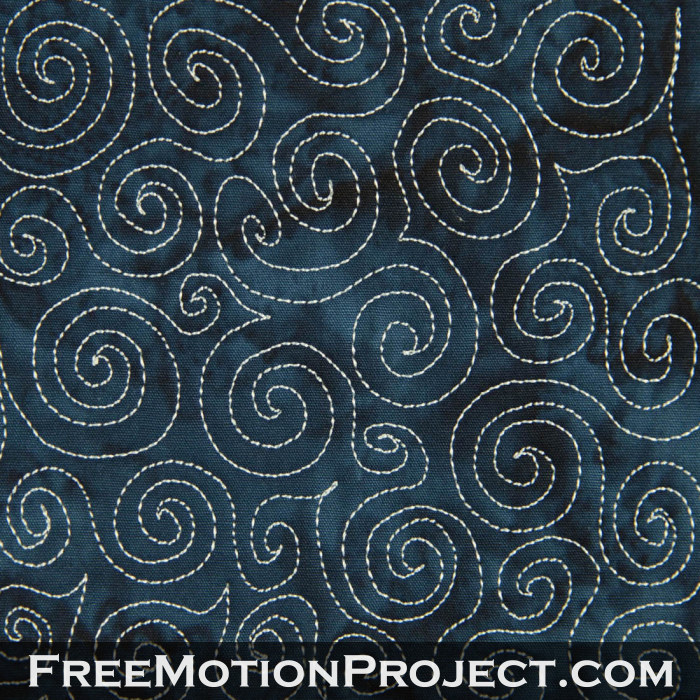Free Motion Quilting Design #5 – Basic Spiral
It ended up taking three tries to quilt this little square! I didn’t like my first tries because of how I ended up with open gaps between the spiral shapes. This is definitely one of those free motion stitches that you could practice over the whole surface of a twin sized quilt and by the time you get done, you’d be a master at it.

Learn how to quilt Basic Spiral
Inspiration – I have seen this filler in a quilt before and was reminded of it when stitching Swirling Flames. Spirals are so beautiful!
Difficulty Level – Beginner. The spirals themselves are not difficult once you get the hang of them, it’s the areas around the spirals that are tricky.
Design Family – Independent.
Directional Texture – All directions! Spirals really grab your eyes and stimulate your mind when you look at them. I love including spirals as motifs in quilts and now they can be added as filler as well!
Suggestions for Use – This is a pretty dominate filler, so you don’t want to put it anywhere you want a solid feel. Those places are always better filled with microstippling. Use Spirals around applique to create movement, particularly around flower shapes. It would also work terrifically as waves, wind, or clouds in a landscape quilt.
Let’s go quilt,
Leah Day

Do you have a video of this filler?
Kris
Not right now, but I'll try to get one shot this month. I'm playing catch up with these older designs as well as creating new designs and it's hard to keep it all straight!
Let's go quilt!
Leah Day
Day 5,Basic Spiral! Ai-yi-yi! This one is awful. I quit trying to stitch it and am spending time doing it over and over with a pencil. I'll come back to it later.
Day Two and ALL of my free motion looks like kids scribble! argh! – Karen –
Linda and Karen, its basic hand eye co-ordination. Think of your needle as a pencil and you are doodling with it.
Start by doing one section of the design only. Repeat and repeat until you get the movement required. Then build it up into the completed square.
Neatness will come in time. Concentrate on the movement of the fabric to get the shape you want.
Its not something that you can do straight away. Your brain needs a bit of rewiring to get get the idea that the pencil is still but the paper is moving.
Try drawing the design on paper and stitching without a thread. start with bigger shapes and work down to smaller ones.
Leah, I've watched a bunch of the low numbered videos, so I can not talk to the upper numbered ones. A suggestion I have is to show the finished product for longer than a half blink of the eye. We kind of need to study it. Thanks for everything you do for us.
Rae
YarnCrafter – Thanks for the suggestion! One thing to remember is you are watching a video, so you can always hit the Pause button and look at the finished image as long as you like!
Cheers,
Leah
Thank you so much for all you do here Leah- I am constantly in awe of your beautiful work and fantastic teaching skills. I'm on my second year of a textiles course at the moment. Although the course is great, it's nice to get some outside inspiration and learning so I don't feel pulled too much in the direction of just my tutor's style and can maintain my own.
Liz
It's not about perfection. Practice on a blank quilt square with colored thread making the curls larger. If you don't get it, try using a matching thread and see how much it shows on the border. And if you're still not happy, use a patterned fabric border and a color thread that will not show as much, until you have done this enough times to improve. I use stippling a lot. It's like jigsaw puzzle pieces. As long as the lines don't cross it's just curly around and back and forth edge to edge. Quilting is not supposed to be perfect. If you want it to be, buy a machine that is computerized and can do it for you. I considered this but practiced until I can do a fairly good job. If people are examining my quilts rather than the spirit in which they are given, it's their loss. I'm sorry if that sounds harsh.
Hi can you do free motion quilting with a brother sewing machine?
Yes, most definitely. It’s not the machine that’s all that important. It’s the foot. You will need a darning foot for your Brother machine.
What kind of foot is that in the scroll video? I’ve never tried free motion, only stitch-in-ditch.
Hi Janet,
I’d advice using the convertible darning foot you already have on your 7700 and here are some extra bases you can use with that foot:
https://leahday.com/products/frame-quilting-foot-set